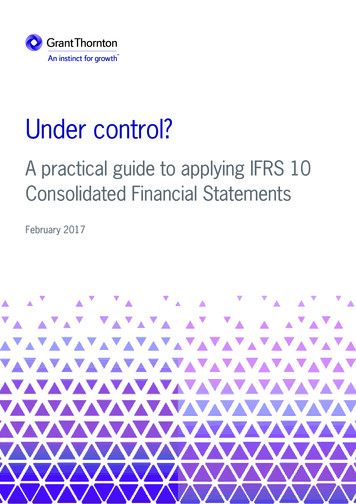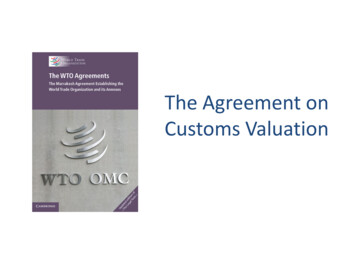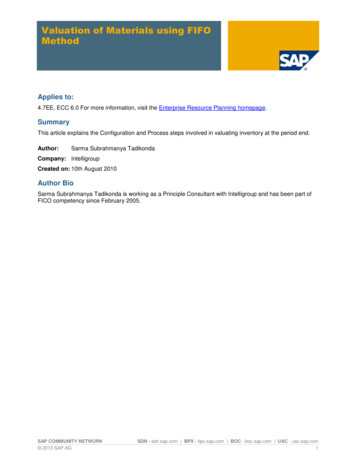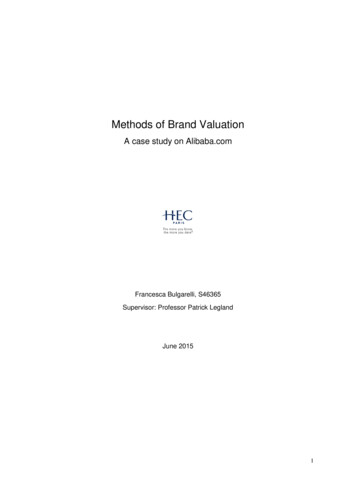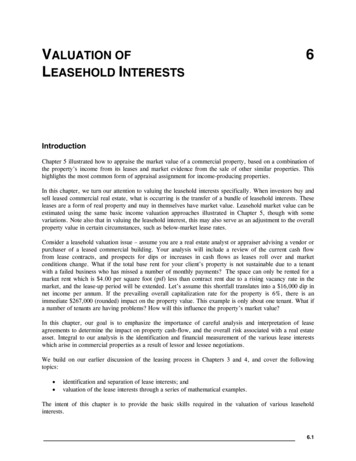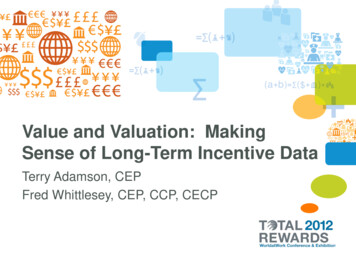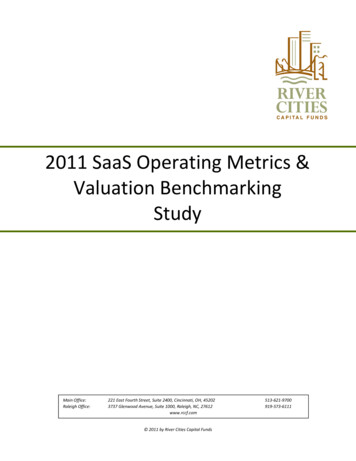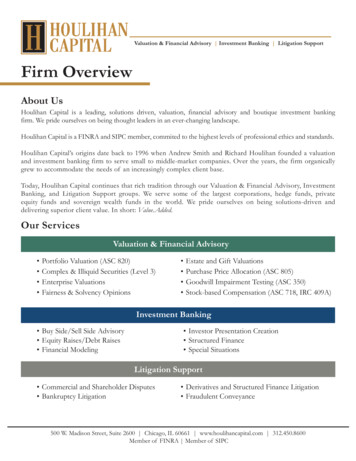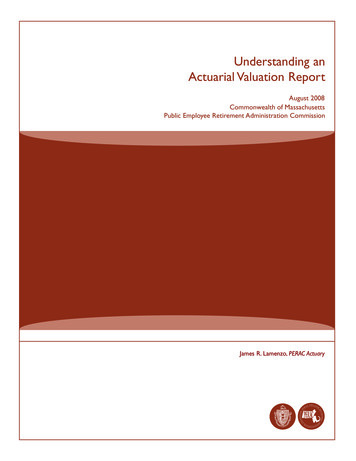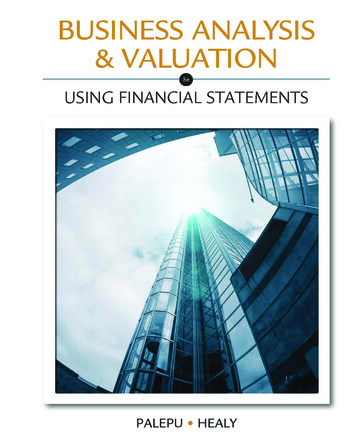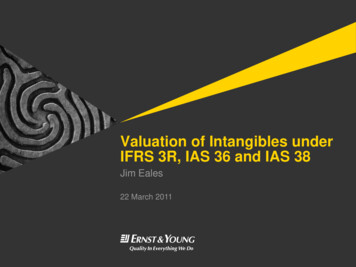
Transcription
Valuation of Intangibles underIFRS 3R, IAS 36 and IAS 38Jim Eales22 March 2011
Agenda Overview of Purchase Price Allocation under IFRS 3RValuation of Intangibles - Approaches & MethodologiesImpairment Testing (IAS 36) and Value In UseQuestionsPage 222 March 2011Valuation of intangibles: IFRS 3R, IAS 36, IAS 38
Purchase price allocation under IFRS 3RIPR&DResearch indefinite lifeuntil start of ed and alised - Amortised ?GoodwillCapitalised and notamortisedTangibleassetsPage 322 March 2011Valuation of intangibles: IFRS 3R, IAS 36, IAS 38
Common intangible assetsMarketing-related intangible assetsContract-based intangible assets Trade marks Licensing, royalty agreements Internet domain names Leasing agreements Non-competition agreements Broadcasting rightsCustomer-related intangible assetsTechnology-based intangible assets Customer lists Patented and unpatented technologies Order or production backlog Software Customer contracts Databases Customer relationships Secret formulas, processesArtistic-related intangible assets Plays Books PicturesPage 422 March 2011Valuation of intangibles: IFRS 3R, IAS 36, IAS 38
Basis of valuation under IFRS 3RIssues to considerBasis of valuation can influence the quantum of value: Fair Value is the basis of valuation for PPA purposes under IFRS 3R, which is defined as:“ the amount for which an asset could be exchanged or a liability settled betweenknowledgeable and willing parties in an arm’s length transaction.” Fair Value under IFRS 3R can differ from “Fair Value” and “Fair Market Value” for legal and taxpurposes. Relevance of actual parties in “market participant” context e.g. buyers specific vs. marketparticipant synergies.Page 522 March 2011Valuation of intangibles: IFRS 3R, IAS 36, IAS 38
Valuation of intangibles (IAS38)Income ApproachMarket ApproachCost ApproachPrimary method under IFRS 3“Quoted market prices in anactive market provide the mostreliable estimate of fair value”IAS38.39If no market exists, fair valuecould be based on similar arms‟length transactionsIf notpossible“Discounting estimated cash flows from the assets orestimating the costs the entity avoids by owning the assets”IAS38.41Approach needs to reflect current transactions andpractices in the industry to which the assets belongs Quoted market prices in an active market typically provide the most reliable estimate for the value of anasset. Only if the prerequisites of the market approach are not fulfilled, the income approach is applied. Thecost approach is applied only if the prerequisites of neither the market nor the income approach can bemet.Page 622 March 2011Valuation of intangibles: IFRS 3R, IAS 36, IAS 38
Market based approaches The market approach determines the Fair Value based on quoted market prices observed in an activemarket. An active market fulfils all of the following conditions:i.the items traded within the market are homogenous;ii.willing buyers and sellers can normally be found at any time; andiii.prices are available to the public. In practice, sales prices, especially for intangible assets, are rarely available since these are typicallytransferred as part of the sale of a business, not in piecemeal transactions. Because intangibles are often unique to a particular enterprise, a comparison between enterprises isoften difficult. For these reasons, the market approach is seldom used and is rarely appropriate for the valuationof intangible assets.Page 722 March 2011Valuation of intangibles: IFRS 3R, IAS 36, IAS 38
Income based approaches The income approach is based on the assumption that the value of an asset is determined by its ability togenerate future cash flows. The income approach involves two steps:1.First, estimate the forecast net cash flows expected to accrue directly or indirectly from ownershipof the asset or a group of assets; and2.Second, the present value of the estimated future net cash flows needs to be determined bydiscounting. The discount rate is derived by reference to an observable capital market yield (e.g. a WACC). The income approach applies the following discounted cash flow methods which vary in the way futurecash flows are attributed to the respective asset:Page 8i.direct cash flow method;ii.relief-from-royalty method;iii.multi period excess earnings method; andiv.incremental cash flow method.22 March 2011Valuation of intangibles: IFRS 3R, IAS 36, IAS 38
Relief from royalty method The approach is based on the concept an owner of an intangible asset does not haveto „rent‟ one and is therefore „relieved‟ from paying a royalty. In using this method, arm‟s-length royalty or license agreements for comparableassets are analysed.Revenues generatedunder trade name The net revenue expected to be generated by the intangible asset during itsexpected remaining life are then multiplied by the selected benchmark royalty rate. The estimated royalty stream after tax is then discounted to present value, whichresults in an indication of the value of owning the intangible asset. IP ownership has to be considered as a bundle of rights or privileges divided amongthe licensor and the licensee and leads to the following equation:Royalty income streamLess tax & protection costslicensor rights licensee rights trademark value These are the right to sell, the right to use, the right to transfer by contract some ofthe benefits for a period of time, etc.Cash flows attributable tothe trade nameIP ValuePage 922 March 2011Valuation of intangibles: IFRS 3R, IAS 36, IAS 38
Profit split analysis A licensee is willing to enter into a transaction only if it can cover its expenses of doing business and canearn a reasonable return on the investment required. Thus the licensee needs to retain a portion of the economic benefit of the licensed trademark. Thelicensee‟s full economic benefit of the trademark is not paid over to the owner in royalties. Profit Split Considerations:i.Which level of profit should be selected?;ii.Are there differences in business model between licensor and licensee?;iii.Differences in regulatory environments/tax structures between licensor and licensee?; andiv.Which margin should we split e.g. historic, short-term or long-term margin?Issues to consider Does the royalty based on a profit split provide a sufficient return on & of the intangible asset in questionover its remaining useful life?Page 1022 March 2011Valuation of intangibles: IFRS 3R, IAS 36, IAS 38
Multi-period excess earnings methodDefinition The MEEM determines the value of an asset based on cash flows that areexclusively generated by the asset in question. Usually, intangible assets can generate cash flows only in combination with othertangible and intangible assets thus it is assumed that the contributory assets arerented or leased from a third party.Post-tax operating profit-Capital employedx required return Accordingly, contributory asset charges (“CACs”) are recognised within the cash flowdetermination to reflect the economic returns on & of all assets employed. This approach is reliable as long as all the intangible assets not subject to thevaluation of the specific intangible asset, but necessary to its exploitation, have beenproperly identified.Issue to consider Estimation of revenue and operating income generated by the intangible asset. Excess earnings attributableto the IP Determination of the expected remaining useful life of the specific intangible asset. Accounting goodwill may not be identified.Page 1122 March 2011Valuation of intangibles: IFRS 3R, IAS 36, IAS 38IP Value
Multi-period excess earnings method As the MEEM allocates the entire residual income to the intangible asset in question (after deduction ofappropriate CACs) it is often used to value core intangible assets. It is therefore fundamental tounderstand the intangible asset hierarchy within the ologyPage 1222 March 2011Valuation of intangibles: IFRS 3R, IAS 36, IAS 38Contracts
Incremental cash flow methodDefinition The incremental cash flow method attempt to quantify the incremental benefit (andhence value) obtained from use of an intangible asset. The incremental cash flow is typically determined by reference to the selling priceand profitability of similar 3rd party products or services that do not incorporate the IPin question i.e. they are “generic”.Cash flow with access tointangible-Cash flow achieved inabsence of intangible An example would be a branded product vs. an unbranded product of equivalentutility.Issue to consider Same issues as the MEEM, plus: Estimation of cash flows derived without access to the IP is often difficult due to alack of truly generic similar products or services. Incremental cash flowattributable to the IPIP ValuePage 1322 March 2011Valuation of intangibles: IFRS 3R, IAS 36, IAS 38
Cost based approaches The cost approach relies upon the principle of substitution and recognises that a prudent investor will payno more for an asset than the cost to replace it new with an identical or similar unit of equal utility.i.Replacement Cost Newis defined as the current cost of producing or constructing a similar new item having the nearestequivalent utility as the asset being valued.ii.Cost of Reproduction Newis the current cost of duplicating an identical item new. Under this approach, adjustments for theloss in value due to physical depreciation and functional and economic obsolescence must betaken into account.Issues Cost to reproduce or replace an asset does not reflect the entire potential of the subject intangible assetto create value (for the business). Often difficult to identify costs directly related to the intangible asset subject to valuation, especially if theintangible asset was created a long time ago.Page 1422 March 2011Valuation of intangibles: IFRS 3R, IAS 36, IAS 38
Commonly applied valuation approachesIntangible assetPrimary valuation approach Example valuation methodsTrademarksIncome ApproachRelief from Royalty / MEEMCustomer relationshipsIncome ApproachRelief from Royalty / MEEMTechnologyIncome ApproachRelief from Royalty / MEEMIncome / Market ApproachMEEMCost ApproachCost to Re-CreateResidualN/ALicencesAssembled workforceGoodwillPage 1522 March 2011Valuation of intangibles: IFRS 3R, IAS 36, IAS 38
Tax Amortisation Benefit: What is it? An adjustment to the values derived by the intangible asset valuation is made to reflect the hypotheticaltax benefits associated with amortising the asset for income tax purposes. TAB is intended to quantify the benefit obtained from the tax savings associated with amortisation ofcapitalised intangible assets. The TAB associated with intangible assets is recognised when the purpose of the valuation is to estimateFair Value under IFRS 3R. This also includes transactions where the specific purchaser will not be allowed to gross up and amortisethe value of purchased intangible assets for income tax purposes.The TAB is a valuation concept, not a tax or accounting concept. Whenever an intangible assetcan be acquired by a bidder eligible for tax amortisation, the TAB value becomes an element forconsideration in Fair Value.Page 1622 March 2011Valuation of intangibles: IFRS 3R, IAS 36, IAS 38
What constitutes goodwill?Cash flowNew products and customersGoodwillExisting operationsTimeIntangible assetsPage 1722 March 2011Valuation of intangibles: IFRS 3R, IAS 36, IAS 38
Impairment testing under IAS36Definition of recoverable amount(Paragraph 18, IAS 36)The higher of an asset’s or a CGU’s: Fair value less costs to sell. Its value in use.Fair value less costs to sellThe amount obtainable from the sale ofan asset or CGU in an arm’s lengthtransaction between knowledgeable,willing parties, less the costs of disposal.Value in useThe present value of the future cashflows expected to be derived from anasset or cash-generating unit.(Paragraph 6, IAS 36)ValuationAccounting calculationPage 1822 March 2011Valuation of intangibles: IFRS 3R, IAS 36, IAS 38
Recoverable amount under IAS36FV less costs to sellValue in Use1. Market ApproachIncome Approach Only2. Income Approach Both approaches reflect market participants‟view Five year business plan agreed by Board Market assumptions (growth, synergies, etc.) Includes buyer-specific synergies Includes committed restructuring Reflect the market risk of the assetadjusted for the country, size, etc.Page 1922 March 2011Valuation of intangibles: IFRS 3R, IAS 36, IAS 38
Discount rate applied for Value in Use Per the standard, the discount rate used should be a pre-tax one. However, no observed market isavailable, hence a post-tax analysis is performed. The discount rate used to determine the VIU should reflect the risks specific to the asset for which thefuture cash flow estimates have not been adjusted. Consideration should be given to risk such as country risk, currency risk and price risk.Beta: Company specific or peer group?Market risk premium: Current terms of capital market in which cash flows are createdCost of debt:1.2.3.Current terms of capital market;Currency of the business plan; andRisk structure of peer group. Specific risk adjustments (size, market, achievability of forecasts etc.)Page 2022 March 2011Valuation of intangibles: IFRS 3R, IAS 36, IAS 38
Pre-tax vs. post-tax discount rate The standard explains the rationale to use pre-tax cash flows and pre-tax discount rates. However this isnot practical from a valuations perspective and in practice we use post tax discount rates to discount posttax cash flows, and then back solve for a pre-tax discount rate for disclosure purposes. This is not thesame as grossing up after tax WACCs. The „pre-tax‟ discount rate typically cannot be directly observed or measured. It is calculated by iteration –by first running DCF calculation using post-tax cash flows and a post-tax discount rate, and thendetermining what the pre-tax discount rate would need to be to cause VIU determined using pre-tax cashflows to equal the VIU determined by the post-tax DCF calculation.Page 2122 March 2011Valuation of intangibles: IFRS 3R, IAS 36, IAS 38
Questions?Page 2222 March 2011Valuation of intangibles: IFRS 3R, IAS 36, IAS 38
Thank you22 March 2011
Customer Relationships Total Purchase Price Research indefinite life until start of use Capitalised and amortised Capitalised - Amortised ? Capitalised and not amortised Page 3 22 March 2011 Valuation of intangibles: IFRS 3R, IAS 36, IAS 38 . Page 4 22 March 2011 Common intangible assets
